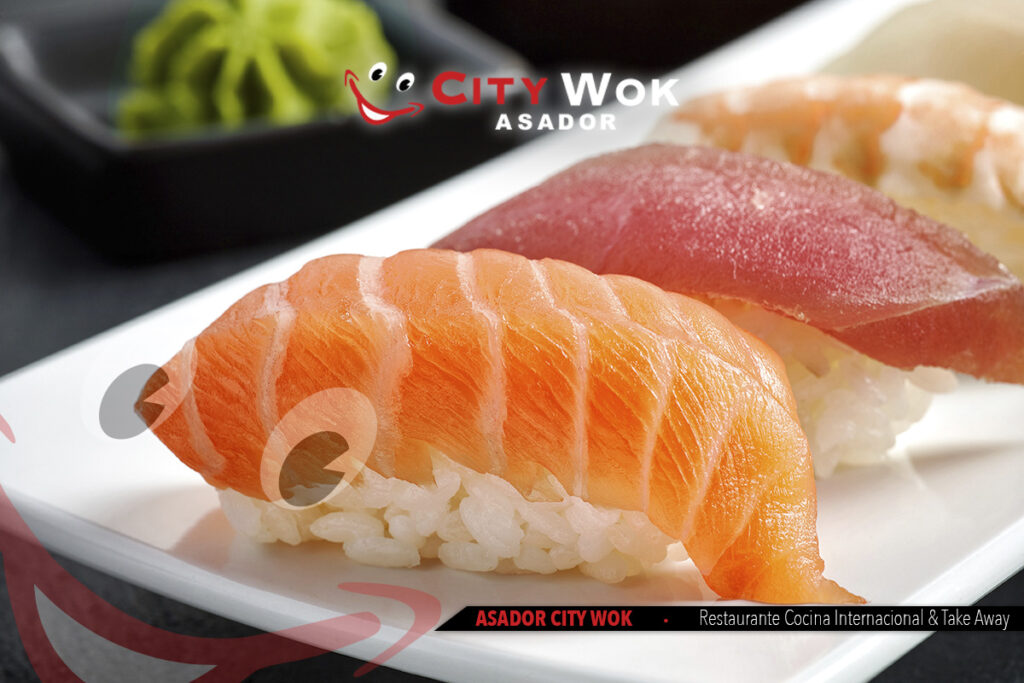Tipos de sushi en City Wok Alfafar (Valencia)

El sushi no es un simple pescado crudo que va acompañado con arroz blanco, es más que eso. El sushi es una forma de preparar el arroz y requiere de un conocimiento previo a su elaboración.
¿Sabías que el sushi no tiene su origen en Japón? El sushi proviene de la antigua China en el siglo IV a.C. dado que existía la necesidad de preservar el pescado y se usaba el moho surgido del arroz fermentado. En el siglo V fue cuando dio el gran salto hacia el archipiélago nipón y evolucionó hasta que se convirtió en lo que conocemos como sushi.
De esta forma, el sushi es el arroz aderezado con vinagre, azúcar y sal, y no el pescado crudo como hemos imaginado hasta ahora. Además, este tipo de arroz va acompañado de pescado crudo y de ahí nace lo que conocemos a día de hoy como sushi.
El sushi ya ha dado el gran salto, traspasando fronteras y llegando a millones de personas que les encanta este tipo de comida. Uno de los tópicos para comer sushi son los palillos chinos, aunque o eres un experto o es casi imposible no hacer el ridículo si no sabes comer con ellos. Aunque la tradición manda y establece que el sushi se debe de comer con las manos y se deben engullir de un solo bocado, es por eso que su tamaño es pequeño y no hace falta que sea cortado para comerlo.
¿El secreto de su elaboración? Una buena pieza de sushi requiere de experiencia y técnica, dos aspectos que cuestan mucho de conseguir. La elaboración de sushi requiere de muchos años de práctica y aprendizaje. Por eso, que cada pieza de sushi está elaborada con pasión y delicadeza.
Sushi en City Wok Alfafar (Valencia)
Aunque parezca un plato de fácil elaboración , el sushi esconde una gran variedad , tanto en formas de preparación y estilos de sushi.
- Maki: es el más conocido. En japonés su significado es rollo, y precisamente eso son los makis: rollos de arroz con pescado crudo y otros ingredientes, todo va enrollado en alga nori.
- Uramaki: es lo mismo que un maki pero a la inversa. Es decir, el arroz es lo que envuelve el rollo de alga nori que contiene diferentes ingredientes.
- Temaki: son conos de alga nori y van rellenos de arroz con diferentes ingredientes. Para hacerte una idea son muy parecidos a los burritos mejicanos pero con ingredientes al estilo sushi.
- Nigiri: este sushi no lleva alga nori, aunque algunas veces lleva un alga como cinta decorativa. Son piezas de arroz amasadas a mano y están cubiertas de pescado crudo.
- Gunkan: consiste en enrollar arroz en una tira gruesa de alga nori hasta formar una especie de cuenco, después se rellena por encima de huevas de pescado.
- Inari: es como un rollito de primavera de tofu frito con arroz aromatizado o verduras.
- Oshi: este tipo de sushi se prensa en una caja y consiste en juntar capas de arroz y pescado o verduras prensadas en el molde que se le conoce como “oshibako”.
- Chirasi: este plato es como si juntáramos en uno mismo varios tipos de sushi pero sin elaborar las piezas. En él se esparcen arroz, pescado crudo y otros ingredientes típicos del
- Hosomaki: este tipo de sushi es pequeño y cilíndrico, y lleva el alga nori en el exterior. Suele llevar un solo ingrediente debido a su tamaño tan fino y pequeño.
- Futomaki: es como el maki pero más grueso, también son más consistentes en cuanto a su contenido ya que se pueden añadir más ingredientes de lo habitual.
En Asador City Wok Alfafar (Valencia) encontrarás platos que permitirán disfrutar de sabores únicos . El sushi es uno de esos alimentos que más demanda contempla. Asador City Wok Alfafar (Valencia) elabora todos sus platos con pasión y mucha paciencia para que salgan unos platos deliciosos.
Pasa un día inolvidable y reúne a tus familiares, amigo o pareja para disfrutar de una comida o cena en Asador City Wok Alfafar (Valencia). Además no te preocupes por los precios, Asador City Wok Alfafar (Valencia) ofrece precios económicos, con un solo precio disfruta de la comida las veces que quieres.
Encuéntranos en C/ Pérez Llácer, 4. El mejor restaurante wok Buffet Libre en Alfafar (Valencia) está situado cerca del centro comercial y de ocio MN4. Puedes comer como un rey con Asador City Wok Alfafar (Valencia).